Friday, March 31, 2006
Arcobalena live at the Salisbury Heights Wedding Expo
The string trio of which I am a part of, Arcobalena, will be playing at the upcoming wedding expo at 1955 Main North Rd, Salisbury Heights, from 11am onwards this Sunday (April 2nd).
Atari 2600 "keypad matrixer"
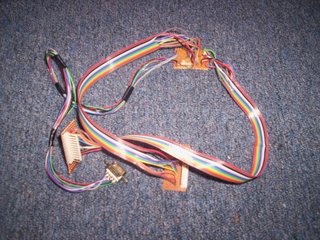
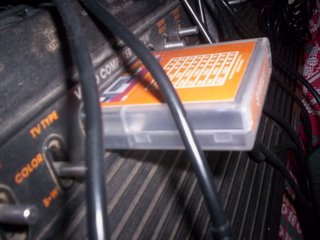
This morning I made a "keypad matrixer" for Atari 2600. Basically, it is like the circuit for the Atari keypad without the keys. It has two 12 pin headers, to connect whatever you want.
Why would I do such a thing? Well, Paul Slocum's Synthcart program uses the keypads as a controller for calling beats and changing the pitch of the two voices... with this thing, it will be easier just to try out an idea for controlling the Synthcart. Tilts, lights buttons, toggles etc etc. I have two copies of the Synthcart.
Labels:
atari 2600,
chipmusic,
chiptech,
diy stuff
Tuesday, March 28, 2006
The London Cuckolds
I am playing the cello with Alex Mitchell on violin at a presentation of the play The London Cuckolds.
Venue: Little Theatre, Adelaide Uni
Dates: Thursday 30th March and Friday 31st March from 7pm
Venue: Little Theatre, Adelaide Uni
Dates: Thursday 30th March and Friday 31st March from 7pm
Sunday, March 26, 2006
Drowning Goldfish live at the Duke of York

Last night, Drowning Goldfish played live with Blix at the Duke of York. The night went okay- but there was a fair amount of driving before hand (we had to drive up to Brent's place to pick up the amps and help him load all the other stuff into the car).
We haven't played live in a very long time, so playing at such a low-key venue was a good thing. Besides the detuned guitars and faster-than-usual tempos (which are both 'Goldfish standards), we played okay, all things considered. Special thanks to Simon Basey (and Blix) for having us there, and to Kyri for mixing us.
Our setlist consisted of the following tracks: Time, Pinebox, Cancer, Back to You, Unsure, Sabotage, Saturn's Tears, Perseverance and Bitterheart.
You can download a version of Bitterheart here (mp3, 6.6mb). It's a long song, but it is my favourite song of ours... so go listen! And listen at least once before you delete it...
Saturday, March 25, 2006
20 mins of gameboy music up
 In the picture, from left to right:
In the picture, from left to right:"The 4th Amigo", "Palbert", "Pampo", "Secret Handshake", unnamed, "Rainbow" and unnamed.
By "popular demand" (well, one request)! Head over to http://www.milkcrate.com.au/_other/gb-mp3s/ to listen to some more crappy gameboy riffs- keep in mind they are all just ideas or something- not really finished things...
The file names mean the following:
gb-00x.mp3: made with lsdj 3.3.39
recorded using one of my old grey gameboys called "Secret Handshake".
(gb-005 was recorded using the old greys "Secret Handshake" and "Pampo" in sync).
gba-00x.mp3: nanoloop 2.0.1
recorded using my as-yet-unnamed silver gameboy advance sp.
gbc-00x.mp3: nanoloop 1.3b
recorded using one of my gameboy colors called "Rainbow".
I would recommend the following files: gb-002.mp3, gb-003 and gba-002. Give the longer tracks some time before stopping them...
Thursday, March 23, 2006
To work and back
You can listen here (1.2 mb mp3) to a crappy riff I wrote on the way to work and back today .
It was made with lsdj 3.3.9 and a silver gameboy advance sp.
It was made with lsdj 3.3.9 and a silver gameboy advance sp.
Wednesday, March 22, 2006
Wall powered modified laser pointer

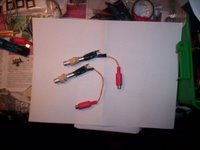
So, after ruining a few laser pointers, I decided to have another crack at the idea of using an adaptor to power some laser pointers. And this time... success! The voltage I was using was significantly lower (3.0 - 3.3V compared to 4.3 - 4.5V last time)... people learn from mistakes...
So what does this mean? Well, for one I can muck around more with using water as a music controller. Lotsafun there. (Actually- it sounds quite effective, and is very sensitive to the player- see my earlier post regarding this). Maybe I will even try to modulate the laser using audio... then modulate the laser in turn with water... which is fed into a computer's audio input... then processed in some way... which is in turn fed into the lasers input... or something. Giddyup!
The spring was negative, and the body of the lasers were positive. I used an rca connection to connect the power supply up. The tip was positive, whilst the shield/ring was negative.
Tuesday, March 21, 2006
Parts arrived yesterday

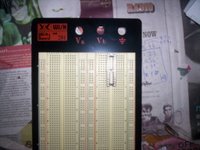
The most integral/ hardest to get parts for an initial stab at microcontroller-ing by yours truly arrived yesterday. The chip I am going to use is an Atmel ATMega8-16-PI. As you can see, the 28 pin socket fits very nicely on an appropriate place on a breadboard.
Hopefully, through the use of these chips, a very cheap way of getting data from the real world (in the form of musical controllers with continuos, analog sensors as well as on/off toggle-like ones) into Max/MSP via the HI object (also like a gamepad etc) will be possible.
Glitch live at Gallery de la Catessen
Last thursday, the Glitch Collective played live for the first time at Luke Altmann's space, Gallery de la Catessen. Partcipants included Tyrell Blackburn, Glenn Brokenshire, Marco Gibardcher, Christian Haines, Tony Marshall, Tristan Louth-Robins, Lauren Sutter, Sebastian Tomczak and Damian West.
It was in a 'classic' format; each person brought a blindly prepared one minute cd-r. Everybody put their CD players on REPEAT and started theirs at the same time. This was played for about twenty minutes.
I was very happy with the outcome- it was like an entire geology made up of sound, with widely varying areas. Tectonic plates would shift, sometimes causing friction and other times allowing more subtle sounds to come through to the upper layer.
It was in a 'classic' format; each person brought a blindly prepared one minute cd-r. Everybody put their CD players on REPEAT and started theirs at the same time. This was played for about twenty minutes.
I was very happy with the outcome- it was like an entire geology made up of sound, with widely varying areas. Tectonic plates would shift, sometimes causing friction and other times allowing more subtle sounds to come through to the upper layer.
Saturday, March 18, 2006
Simple max graphing patch
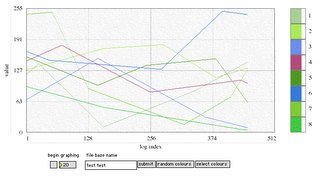
So, I recently started writing a simple graphing patch for max. Currently, it features:
- Plot up to eight streams of data on the one graph
- 512 data points per stream are held on one graph
- The graph automatically refreshes once the right hand side is reached
- Once one screen is filled up, an indexed pitcture of the graph is saved, with a user-defineable base name
- User can set the rate of data sampling
- Eventually, a rocking soundtrack!
Friday, March 17, 2006
Gameboy unsync






I've been toying with the idea of writing a piece of music that explores the subtle unsyncing of gameboys. To the left, you can see the lsdj song I have started working on; it is very simple, using just the two pulse voices.
This song would then be uploaded to three old grey gameboys, who have all had their start-buttons hardwired to the same switch. When I press the swtich, they all start at the same time. Eventually they will drift, causing an unsyncing... a glitch of sorts...
Tuesday, March 14, 2006
Duet For Two Desklamps mp3 up

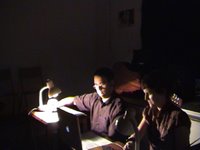

At last, I have had a chance to convert the audio from last week's Hidden Village performace to MP3.
So here it is... (MP3, stereo, 128 KBps, 6.6MB)
My nano glitch minute...
I have been thinking about what I will use for my glitch minute for Thursday night's concert at the de la Catessen gallery. I had many, many ideas- after all, sixty seconds is actually quite a long time- but I have just finished something that I am quite happy with.
My minute is a quiet, peaceful, ambient one. It has been written using Nanoloop 2.0.1, running on a Gameboy Advance SP Silver.
Download the minute here. (MP3, stereo, 128KBps, 940 KB)
My minute is a quiet, peaceful, ambient one. It has been written using Nanoloop 2.0.1, running on a Gameboy Advance SP Silver.
Download the minute here. (MP3, stereo, 128KBps, 940 KB)
Monday, March 13, 2006
49 toggle usb array...
It is possible to intepret signals from a standard, non-analog (and therefore significantly cheaper) usb-based gamepad and use a 49 toggle array as an interface. Of course, if an analog one is used, up to 64 toggles can be used.
The downside is that the array will produce blindspots if interpreted 'blindly'. In the image below, the three red points represent physical connections made in the array. The grey one is a 'phantom' blindspot- if the three red connections are made, the fourth will also be made automatically... the points are not independent as such, but are created by cross referencing two of the button on the pad. This method is similar to the Atari 2600 CX-50 keypad controller- where a matrix of three by four pins is used to get twelve inputs- and similar devices.
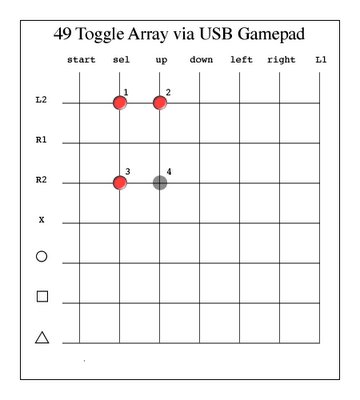
Clever programming on a case-by-case basis of use might be able to overcome some instances of this.
This system could perhaps be a cheap way to combine music and certain board games. But before I have a concrete idea, I am not going to venture down this thorny path...
The downside is that the array will produce blindspots if interpreted 'blindly'. In the image below, the three red points represent physical connections made in the array. The grey one is a 'phantom' blindspot- if the three red connections are made, the fourth will also be made automatically... the points are not independent as such, but are created by cross referencing two of the button on the pad. This method is similar to the Atari 2600 CX-50 keypad controller- where a matrix of three by four pins is used to get twelve inputs- and similar devices.

Clever programming on a case-by-case basis of use might be able to overcome some instances of this.
This system could perhaps be a cheap way to combine music and certain board games. But before I have a concrete idea, I am not going to venture down this thorny path...
Sunday, March 12, 2006
New Kotlinski label
Just thought I would add a post about the fact that LSDJ creator and all-round gameboy god (and good guy) Johan Kotlinksi [aka Rolemodel] has opened his new chiptune shop at http://www.rebelpetset.com/. There he will stock micromusic type stuff from Sweden and the world over. I am sure he will have some fantastic stuff in his catalogue!
Milkcrate at the Mildura Brewery

Milkcrate Six was screened on the 11th of March (yesterday) as part of the Mildura Wentworth Arts Festival. Tony Marshall, Martin Victory, Tristan Louth-Robins, Damian West, Lauren Sutter and myself all went up. It was played in quite a public space (the Brewery, on a Saturday night at 10:30), and was functioning more as background music/visuals than a concert/screening as such. I hope it was received well- it is difficult to tell with these things. Certain freqency ranges were being overpowered by the room/background noise. Interestingly, the music was easier to hear in the restrooms...
Thanks to Mario and Joanne at the Mildura Brewery for having us there, and Kim Chalmers for organising the event. Also, a special thanks to Mr. West for editing and Mr. Victory for driving.
 |  |
 |  |
Hidden Village live at Gallery de la Catessen
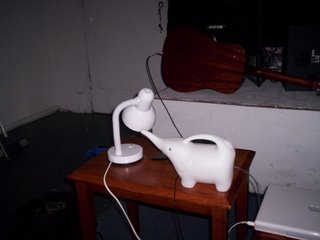
As part of the Tyndall Assembly series of concert, Hidden Village (Sebastian Tomczak and Lauren Sutter) performed live last Thursday. The work we performed was Duet for Two Desk Lamps and was received quite well. Lauren and I were quite happy with it, considering that it was very quickly prepared, since I had burnt out/ hacked up/ trashed all of my lasers for the Toriton piece (see previous post about using water as a controller). Christian Haines and Tristan Louth-Robins also had pieces in this concert.
Duet for Two Desk Lamps used two standard lights (Kambrook KDL30W- 60W- $11.86) from Big W as music controllers. Two solar panels from Dick Smith (0.45Vk, 1A- o2001- $6.99) were wired directly to two RCA leads (just ones I bought from cheap as chips or whatever for $2 for 3). The ground went to (-) and the signal went to (+), but this could be the other way around also.
Both of us were controlling four oscillators each. This bank of four consisted of:
- One sine wave whose frequency was set, but whose amplitude was directly modulated from the solar panel. (osc 1)
- One sine wave whose frequency was dependent on the average peak over the previous second from the solar module; the higher the peak, the higher the frequency. Also, the amplitude was directly modulated from the solar panel. (osc 2)
- Two sine waves whose frequencies were dependent on the average peak over the previous 3- 10 seconds from the solar module of the other player; the higher the peak, the higher the frequency. Also, the amplitude was directly modulated from the solar panel. (osc 3 + 4)
Average amount of energy generated by the solar panels also controlled delay time in an asymetric feedback network. The amount of energy change currently coming from the solar module also controls the amount of feedback seen in this network.
Control was exerted in the piece via two main techniques. Either the lamp was turned on and off (to produce more 'blips' in the directly controlled sine waves), or the lamp's neck was quickly moved back and forth, so that the outer edge of the spotlight was constanltly moving on and off the solar panel (thus, a more shimmering and gradual effect over the sound can be achieved).
The piece has the following form
- Technique: Clicking, Osc 1a and 1b, then 1a, 1b, 3a and 3b, 2mins
- Technique: Waving, Osc 2a and 2b, then 2a, 2b, 4a and 4b, 2mins
- Technique: Clicking and Waving, All osc simultaneously and alternating, 3mins
Next week: Shivna Kaun and The Glitch Collective...
Wednesday, March 08, 2006
Good console mod site
Here is a retro console mod site with good guides and clear pictures / explanations.
Monday, March 06, 2006
Mac max/msp patches on windows... what a pain!
So, I went over to Damo's place yesterday afternoon. Partly to give back his g4 laptop (what a bargain!) but also to try out my light-to-midi max patch/ app/ whatever. I thought it would be a walk-in-walk-out type scenario.
Oh boy was it a headache! In the end, the program had to be modded to include variable frequency for the control signal, from 10Hz to 80Hz (earlier it was just 10Hz). The windows machines (both that we tried on) had huge trouble dealing with the 10Hz signal in any reasonable way... although I should have thought of this in the first place... anywho, now I have a standalone .exe for the patch, so that is a good thing, too.
Thanks for all your time and help yesterday, Damian- I owe you one!
Oh boy was it a headache! In the end, the program had to be modded to include variable frequency for the control signal, from 10Hz to 80Hz (earlier it was just 10Hz). The windows machines (both that we tried on) had huge trouble dealing with the 10Hz signal in any reasonable way... although I should have thought of this in the first place... anywho, now I have a standalone .exe for the patch, so that is a good thing, too.
Thanks for all your time and help yesterday, Damian- I owe you one!
Sunday, March 05, 2006
My light to midi
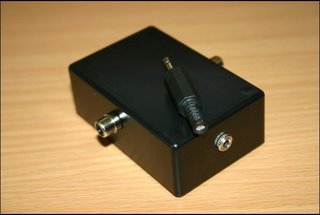
 I have just finished a preliminary version of the manual for the L2M interfaces I started selling on eBay last week. I will also be offering them on the internet via PayPal.
I have just finished a preliminary version of the manual for the L2M interfaces I started selling on eBay last week. I will also be offering them on the internet via PayPal.Download the manual here (PDF, 168KB) and you can view one on eBay here.
Friday, March 03, 2006
Tilt controller synth from a psx pad
Well, recently I've been mucking around with the dualshock 1 and 2 (and third party equivalents). Of course, you can pick them up via a usb converter using the 'hi' object in Max/MSP. EB Games/ EB Boutique quite often have a pack of two third party dualshock 2 controllers for $23, and the usb converter can be bought quite cheaply from ebay.
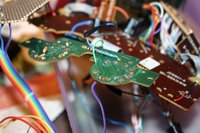
The inputs from the pad include sixteen digital on/offs (left, right, up and down on the d-pad, x, triangle, circle, square, l1, l2, l3, r1, r2, r3, start and select) and four 8-bit analog inputs (analog left x and y and analog right x and y). However, the d-pad on/offs are not independent; left and right cannot be switched on at the same time. The same with up and down.
I made a quick trial, by shoving mercury tilt switches into a styrofoam ball. The orientation of the ball along the vertical plane turned on and off different harmonics in a quick'n'dirty additive synth.

Although the digital on/offs work great (they are very quick to react), I'm still having trouble getting high quality data from the analog inputs. More on this soon...

The inputs from the pad include sixteen digital on/offs (left, right, up and down on the d-pad, x, triangle, circle, square, l1, l2, l3, r1, r2, r3, start and select) and four 8-bit analog inputs (analog left x and y and analog right x and y). However, the d-pad on/offs are not independent; left and right cannot be switched on at the same time. The same with up and down.
I made a quick trial, by shoving mercury tilt switches into a styrofoam ball. The orientation of the ball along the vertical plane turned on and off different harmonics in a quick'n'dirty additive synth.

Although the digital on/offs work great (they are very quick to react), I'm still having trouble getting high quality data from the analog inputs. More on this soon...
Using a water surface as a controller...
 | 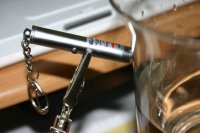 |
 |  |
As you probably don't know, Lauren and I will hopefully be using water surfaces as music controllers live at the Tyndall concert next Thursday. The concept for this comes from a yearning to touch sound.
The idea is pretty damn simple- a laser beam from one of those annoying pen pointers is projected diagonally through a glass vase containing some water, so that it hits the surface and also comes out on the other side.
A basic receiver directly translates movement of the laser (via changes in the water surface) to a wave that can be read on an audio line on on the computer.
The good aspect of this is that the state of the receiver can be read as quickly as audio (...it is audio...). However, the wave does not represent any discrete amounts of energy or steps or whatever, since it represents any particular energy state of the laser (or the receiver) as a fixed, static voltage (unchanging) ie. direct current, which analog to digital audio converters do not seem to like.
So what the wave is showing is the fact that the water is surface is moving in some way- it is showing it is changing, not exactly how much change happens from here to there. At least that's the way it works in my head or something.
This wave is then used to directly modulate audio (like a sine wave or something) and is also translated into data for controlling delay time and feedback values in an asymetric feedback network as well as sine wave frequency. Data is also crossed over from one player to another.
Anyways- this is just the beginning. There's lots of room for development for this idea, I suppose.
Wednesday, March 01, 2006
Master System Mods
S-video out: http://arakon.dyndns.org/Gen1svideo.html
Throw away that stupid RF switch.
60 Hz Switch: http://home.freeuk.net/markk/Consoles/SMS_50-60Hz_Switch.txt
At last play your pal games at the speed they were made for.
I personally haven't tried these yet (maybe this weekend?). But- I just picked up two SMS2's at the fortnightly Brighton car boot sale. There's always this one guy with an amazing amount of retro game stuff... where does he get it all from? This one time, he had a collection of 65 master system games as a set, almost all boxed- there ARE only roughly 360 games for the damn thing! And there were some classics in there, too...
Throw away that stupid RF switch.
60 Hz Switch: http://home.freeuk.net/markk/Consoles/SMS_50-60Hz_Switch.txt
At last play your pal games at the speed they were made for.
I personally haven't tried these yet (maybe this weekend?). But- I just picked up two SMS2's at the fortnightly Brighton car boot sale. There's always this one guy with an amazing amount of retro game stuff... where does he get it all from? This one time, he had a collection of 65 master system games as a set, almost all boxed- there ARE only roughly 360 games for the damn thing! And there were some classics in there, too...
Milkcrate.com.au is up!
Yes, it's true. The official, genuine Milkcrate project website is up and running now. Check it out now at: www.milkcrate.com.au.
In case you didn't know, milkcrate is "music with rules constraining time, space, efficiency and materials."
In case you didn't know, milkcrate is "music with rules constraining time, space, efficiency and materials."
Subscribe to:
Comments (Atom)


